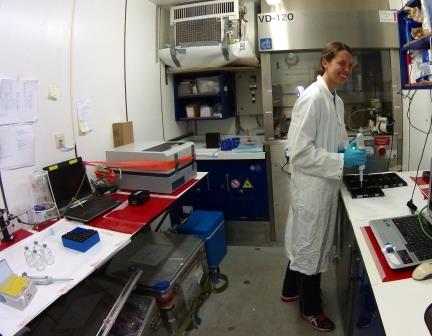As mentioned in the previous blog entries, the area off Peru is very special, because parts of the water column contain low oxygen concentration or oxygen is even completely absent. I am interested in the very small inhabitants of the water column which adapted to live in the oxygen rich as well as in the oxygen depleted zones: bacteria. Some of them are able to use alternative electron acceptors, for example nitrate, instead of oxygen and can therefore life under anoxic conditions. Still the energetic yield by using alternative electron acceptors is lower compared to the reduction of oxygen. Therefore reduced bacterial activity may result under oxygen poor conditions. But why do we care about the bacterial activity at all? These small organisms are important for the recycling and turnover of organic matter (carbon containing substances) and nutrients in the ocean. Thus they provide food for higher trophic levels. Since bacteria are small in size they can only take up organic matter which is dissolved and smaller than around 1 kDa (kilo Dalton). In cases of larger “food”, they have to produce enzymes and excrete them into the environment. These enzymes function as little scissors and cut specific substrates into smaller pieces, which can then be taken up by the bacteria.
My work focuses on the effect of oxygen depletion on bacterial activity. In my lab, which is a container on the deck of the METEOR, I filter seawater to analyze the quality of the dissolved organic matter. One parameter is the amount of dissolved organic carbon which consists of amino acids and sugars. Moreover I’m taking samples to determine the cell abundance and last but not least I’m measuring the abundance and efficiency of the so called “extracellular enzymes” (the enzymes which are excreted by the bacteria). For that I add different specific substrates (f.e. sugars and amino acids) to the bacteria, which start fluorescing, as soon as they are cut by the enzymes. This fluorescence can be measured by a photometer. At each station I sample all these parameters at several depth along the oxygen gradient. This means a lot of pipetting work, but it is worth it!
Although my “little friends” cannot be seen with the naked eye, they are a major part of the marine ecosystem, which keeps it running and they are MANY- if you take a closer look with a special
microscopes; in one mL of seawater you will find around one million bacteria!

Marie Maßmig, GEOMAR, Kiel